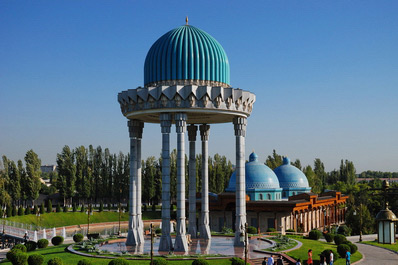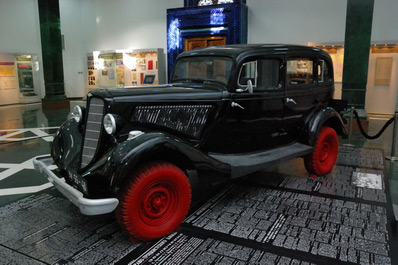Museum of victims of repressions, Tashkent

Uzbekistan, a country that keeps tight control over information on current events, is taking tentative steps toward an exploration of its recent past. A new museum in Tashkent is devoted to raising awareness about repression during the tsarist and Soviet eras.
During the early years of Uzbek independence, official policy emphasized the renewal of ancient national traditions over the exploration of the recent past. The emphasis began to change in mid-1999 with the Cabinet of Ministers' resolution on "immortalizing the memory of those who sacrificed themselves for the freedom of their nation and people." In a country where public discourse is still dictated from the top down, this resolution laid the framework for public discussion of "victims of the colonial era" and "victims of repression."
The 1999 resolution led directly to the opening of the Museum of the Victims of Repression. The museum is located in the new Martyrs' Memorial Complex, which honors those who suffered under Russian and Soviet colonial rule. The blue-domed building contains exhibits on the recent history of the territory that now comprises Uzbekistan, ranging from the first Russian incursions against the Khanate of Khiva (a powerful state from the 16th century until Russia conquered it in 1873) to the "cotton affair" of the 1980s.
Many exhibits draw on information culled from the former KGB archives - offering the general public unprecedented exposure to the records of the former Soviet secret police. Still, museum curators have been careful to limit the scope of exhibits. For example, only the names of victims are listed in various displays. The identities of perpetrators are not mentioned.
Displays are arranged in chronological order. The first set of exhibits provides general historical information about the era of the "great game" played between the Russian and British Empires for control of Central Asia. In the next set of display cases, the purpose of the museum comes into better focus as individuals who participated in 19th century anti-tsarist uprisings in Tashkent and Andijon are listed by name, and their fate spelled out: Some were hanged, others exiled or sent to prison.
The museum, which opened in August, devotes the bulk of its space to the Soviet period, especially the Stalinist era. Documents are used to convey a sense of the cold rationality of the Great Terror. In a display on the "dekulakization campaign" of 1932, a chart clearly outlines the number of livestock and personal items "expropriated" from kulaks, or rich peasants. Other display cases show arrest warrants, execution orders, signed confessions, and pleas for family members.
Two other displays merit mention: one concerning World War II - era deportees, including Crimean Tatars, Koreans, and other ethnic groups that allegedly collaborated with the Soviet Union's enemies; the other concerning Moscow's anti-corruption campaign against Uzbek officials in the 1980s, dubbed the "cotton affair." This exhibit also covers the damage done by Soviet central planning to Uzbekistan's environment and public health.
The exhibits and interior layout seem to have been designed to leave a suggestion in the visitor’s mind that Moscow authorities bore a large share of the blame for many of Uzbekistan's current difficulties, including an inefficient agricultural sector and outmoded industrial base. But Professor Naim Karimov, head of the Martyrs' Memorial Charitable Fund, said the displays are not intended to stir up negative feelings concerning Russia's influence over Uzbek development.
"The Russian Embassy got in touch with me when we first began this project, and naturally they were concerned. But I explained that we aren't saying that Russia did this or that Russians did this - it was the whole Soviet system," Karimov said.



